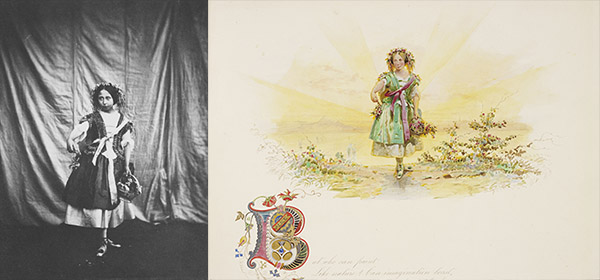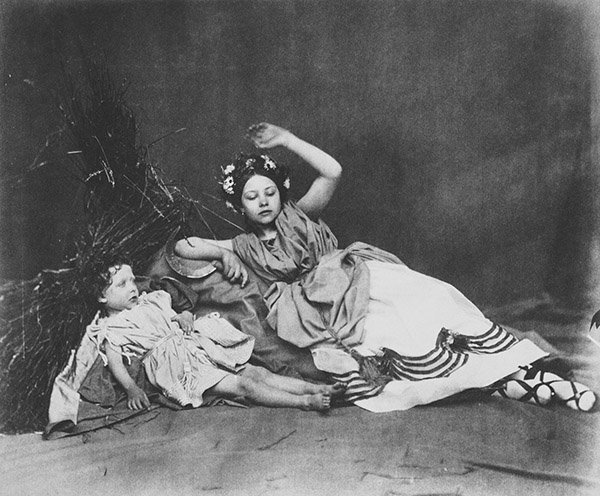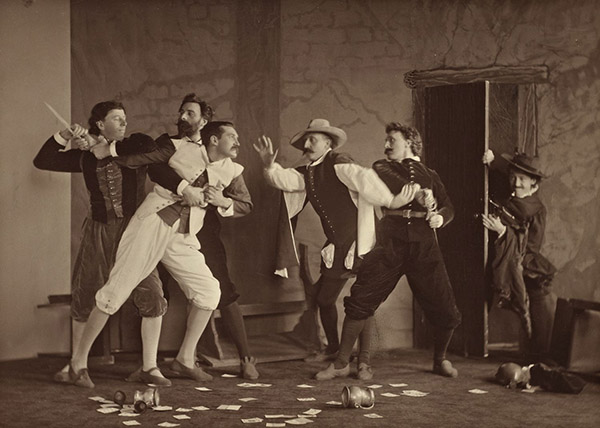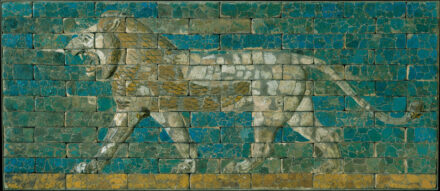A remarkable album in the Royal Collection depicts the dress-up play of Queen Victoria’s children

Princess Alice as “Spring” in the Tableaux of the Seasons, 1854. Left: photograph by Roger Fenton; Right: Watercolor by Carl Haag. Royal Collection Trust / Her Majesty Queen Elizabeth II 2014
On February 10, 1854, Queen Victoria noted in her Journal: “…the Children had kindly arranged a charming surprise for us. The room was entirely darkened…Alice as spring, recited some very pretty verses from Thompson’s Seasons…”
One of the many delights in the Getty Museum exhibition A Royal Passion: Queen Victoria and Photography is the Royal Children Tableaux album, generously loaned by Her Majesty The Queen from the Royal Collection.
The royal children frequently performed tableaux—posed scenes in costume, inspired by art or literature—as well as plays and dances on special occasions for their parents. One of these, Tableaux of the Seasons, was performed at Windsor Castle on February 10, 1854, by Queen Victoria and Prince Albert’s seven eldest children in honor of their parents’ 14th wedding anniversary. The scenes were based on The Seasons by the 18th-century poet James Thomson, and were photographed by Roger Fenton. The photographs have a plain background of drapery—the finished scenes were then to be painted by Carl Haag, each with some lines from Thomson’s poem written below.
Both Fenton’s photographs and Haag’s painted versions were subsequently mounted in an album (the Royal Children Tableaux album), which was given to the Queen by Prince Albert on her birthday, May 24, 1854. The Queen records in her Journal, housed in the Royal Archives at Windsor, that the work was “exquisitely done…Nothing could have given me more pleasure.”
Tableaux of the Seasons consisted of four scenes: Spring (see above), Summer, Autumn, and Winter, plus an additional concluding scene in which all the children posed together.

The Princess Royal and Prince Arthur as “Summer” in the Tableaux of the Seasons, 1854, Roger Fenton. Royal Collection Trust / Her Majesty Queen Elizabeth II 2014
Prince Alfred (1844–1900), as Bacchus, was chosen to represent Autumn. He is pictured seated on a wine barrel wearing a panther’s skin, with long curls falling from beneath a wreath of grapes and holding aloft a goblet of wine.

Prince Alfred as “Autumn” in the Tableaux of the Seasons, 1854, Roger Fenton. Royal Collection Trust / Her Majesty Queen Elizabeth II 2014
Queen Victoria noted in her Journal that the depiction of Winter was “…almost the prettiest tableau.” The Prince of Wales (1841–1910) and his sister Princess Louise (1848–1939) sit either side of their “fire,” over which a cauldron hangs. The Princess holds her hands out towards the fire as if to warm them. “Bertie” sports a long white beard; his cloak is covered with snow.

Princess Louise and the Prince of Wales as “Winter” in the Tableaux of the Seasons. Left: photograph by Roger Fenton; Right: Watercolor by Carl Haag. Royal Collection Trust / Her Majesty Queen Elizabeth II 2014
The fifth and concluding tableau brings together the four seasons, with Princess Helena (1846–1923) as the Spirit Empress standing aloft, her long veil hanging down to her feet, a cross in her left hand.

Princess Alice as “Spring,” Prince Arthur and the Princess Royal as “Summer,” Princess Helena as “The Spirit Empress,” Prince Alfred as “Autumn,” Princess Louise and the Prince of Wales as “Winter” in the fifth and concluding Tableau of the Seasons, 1854, Roger Fenton. Royal Collection Trust / Her Majesty Queen Elizabeth II 2014
Queen Victoria summed up her feelings about the evening’s entertainment:
The scenery was admirably adapted to each Tableau & appropriate music was played between each. They all looked and did their parts so well…We were all delighted, & the whole, was such a pretty idea.
The royal family’s enthusiasm for plays and tableaux vivants did not diminish as the years passed and the children grew up. Many of these entertainments, which would have involved many hours of rehearsal, have been recorded in photographs that are now in the Royal Collection, including this image, taken at Osborne House in January 1891:

Princess Louise and Mr. Cowell in Elaine, 1891, Hughes & Mullins. Royal Collection Trust / Her Majesty Queen Elizabeth II 2014
This scene, “Elaine,” from The Idylls of the King by Tennyson, recreates the tragic end of the tale. Elaine has died from a broken heart, her love for Lancelot unrequited. We see her body lying in a small boat, a letter in one hand, a lily in the other, the oarsman guiding the boat towards Camelot. Queen Victoria’s daughter Princess Louise (seen above in the Winter tableau) played the part of Elaine.
Ideas for tableaux came not only from literature, but also from art, as in the scene below after Jean-Louis-Ernest Meissonier’s painting of 1855, La Rixe (The Brawl). This painting, purchased by Emperor Napoleon III and presented to Prince Albert on his birthday in August 1855, used to hang at Osborne House, where this tableau was presented on January 8, 1891.

Arthur, Duke of Connaught, in The Brawl, 1891, Hughes & Mullins. Royal Collection Trust / Her Majesty Queen Elizabeth II 2014
Arthur, Duke of Connaught (wearing a hat), is seen in a very different role to the one he played in the Summer tableau of 1854. Here he has become involved in a tavern brawl. There is real drama and tension, tables and chairs have been overturned and tankards and cards—most probably the cause of the trouble—lie scattered on the floor.
Find out more about photography in the Royal Collection here.
Text of this post © Lisa Heighway. All rights reserved.




Comments on this post are now closed.